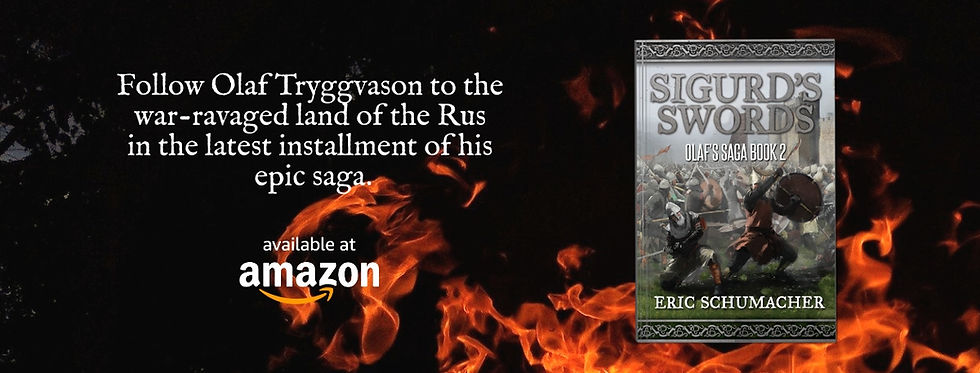Novgorod, Holmgard, and the Rus
- Eric Schumacher
- Mar 4, 2023
- 4 min read
My novel, Sigurd’s Swords, takes place in the kingdom of the Rus’, known to early Scandinavians as Gardariki, or the “realm of towns.” I was extremely excited to dive into this new world of the past, though it did not come without its challenges. As with most research into the Viking Age, one must rely on sources written years and sometimes centuries after the events occur. Such was the case with Olaf Tryggvason and his time in Gardariki.

For the most part, researching the setting revealed very straightforward findings. Staraya Lagado was Aldeigjuborg, Konugard was Kiev. But one town differed: Novgorod. This blog post investigates the town and why it presented more questions than answers for a humble writer like me.
I hope that this post provides a small glimpse into the world of reconciling history with fiction.
The Existence Of Novgorod
When I began researching Holmgard and Novgorod, I ran across a research paper written by Evgenij N. Nosov from the Academy of Sciences of the USSR (1987). In it, I found this:
Scandinavians in general were well acquainted with the geography of Eastern Europe. Excavations in Ladoga, at the lower Volkhov date their first appearance to the second half of the 8th century. In all probability, they reached the upper reaches of the Volkov at approximately the same time. They were not familiar with the name “Novgorod” and called the Northern Russian capital “Holmgard.”

The name “Novgorod” means “new town.” It is mentioned in the Sofia First Chronicle as existing in AD 859. The Novgorod First Chronicle (aka The Chronicle of Novgorod) mentions it as first existing in the AD 860s. The Russian Primary Chronicle states that in 860-862, the Slavs invited the Rus to rule them and that “The oldest, Rurik, located himself in Novgorod;…”
By all accounts, it seemed that Novgorod existed at the time of my story, which takes place in the late 900s. But something wasn’t adding up…
Holmgard Vs. Novgorod
The name Holmgard (Old Norse: Holmgarðr) means “island compound” or “island settlement.” The name makes sense, especially to early Scandinavians who traveled to Gardariki in the spring after the ice melted and when heightened water levels made ship travel easier. Due to the Volkhov flood plain in the Novgorod area, settlements would have presented themselves as a series of islands, hence “island settlement” or the plural, “island settlements.” Was Novgorod one of these island settlements?

Another question arose because of the date of the chronicles mentioning Novgorod. Those chronicles were written long after the 9th century. It is easy to imagine that they might have been off by years in their reckoning of Novgorod’s first appearance.
Finally, and most troubling, archeological studies in the area of the Novgorod city center have found no evidence of settlement during the 8th or 9th centuries when Rus were beginning to arrive in the area. Instead, archaeology suggests that the settlement was closer to the latter half of the 10th century.
So early Scandinavians were arriving in the area and calling someplace Holmgard, but that place wasn’t Novgorod. So, what was it?
Gorodische

2km closer to Lake Ilmen and on the opposite side of the Volkhov River from Novgord we find Gorodische. Gorodische is a hillfort around which lay a settlement. Based on finds in the area, this hillfort was in existence during the 8th and 9th centuries and is believed to have been the fortress of the princes of that area. In fact, archeological finds in the area suggest that early on Gorodishche was a military-administrative, trading, and handicrafts center situated on the banks of the Volkhov. Could this have been Holmgard? It seems to fit the description.
Putting It All Together
Olaf Tryggvason sought refuge with his uncle in Gardariki in the latter half of the 10th century. Novgorod could very well have been in existence at that time. Heimskringla says he dwelt in Novgorod.
A further clue here is helpful. The name Nygard, which means “new settlement” in Old Norse, is found in the 10th-century policy manual De Administrando Imperio written by Byzantine emperor Constantine VII between AD 948 and AD 952. If this Nygard is Novgorod, then we can be more certain that Novgorod was in existence when Olaf was there.
Given all of the information above, here is what I imagined for the setting of Sigurd’s Swords: there is a hillfort on the site that is now called Rurikovo Gorodische. Around it is an older town that thrives in the limited amount of real estate it can use, given the flood plains that encircle it. The Rus called this place Holmgard. Downriver 2K is the “new town,” which has sprung in the decades before Olaf’s arrival on the scene. Olaf and his Rus comrades would have called this place “Nygard.”
Does It Matter?
As a historical writer, I always ask myself: does it matter to the reader? I don’t always get an affirmative response from my brain or my gut, but in this case, I did. Accuracy matters. To the casual reader, it matters because they might pick up a bit of history that they didn’t know before. To the historical reader who loves history as much as I do, an inaccuracy can toss the reader out of the story or worse, hurt the writer’s credibility. So I endeavor to get it right, or at least make it plausible, even if the research acts as a small backdrop in a grand tale and never really sees the light of day.
Thanks, as always, for reading.
First published on Eric's website





Fascinating post, and it reminds me once again of the challenges when writing historical fiction. Also since currently I look at maps of Ukraine every single day, it is cool to be reminded of this early history.